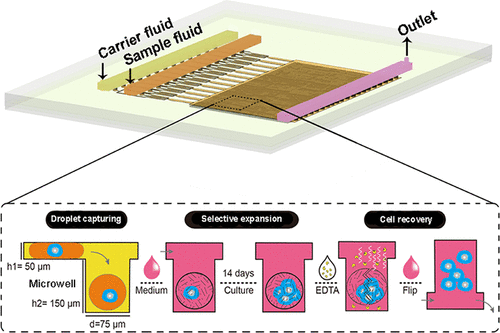当前位置:
X-MOL 学术
›
Anal. Chem.
›
论文详情
Our official English website, www.x-mol.net, welcomes your
feedback! (Note: you will need to create a separate account there.)
Microgel Single-Cell Culture Arrays on a Microfluidic Chip for Selective Expansion and Recovery of Colorectal Cancer Stem Cells
Analytical Chemistry ( IF 6.7 ) Pub Date : 2021-09-08 , DOI: 10.1021/acs.analchem.1c02335 Dongguo Lin 1, 2, 3 , Xiao Chen 1 , Yang Liu 1 , Zhun Lin 1 , Yanzhang Luo 2 , Mingpeng Fu 2 , Na Yang 2 , Dayu Liu 1, 2, 3 , Jie Cao 1, 4
Analytical Chemistry ( IF 6.7 ) Pub Date : 2021-09-08 , DOI: 10.1021/acs.analchem.1c02335 Dongguo Lin 1, 2, 3 , Xiao Chen 1 , Yang Liu 1 , Zhun Lin 1 , Yanzhang Luo 2 , Mingpeng Fu 2 , Na Yang 2 , Dayu Liu 1, 2, 3 , Jie Cao 1, 4
Affiliation

|
Cancer stem cells (CSCs) are rare and lack definite biomarkers, necessitating new methods for a robust expansion. Here, we developed a microfluidic single-cell culture (SCC) approach for expanding and recovering colorectal CSCs from both cell lines and tumor tissues. By incorporating alginate hydrogels with droplet microfluidics, a high-density microgel array can be formed on a microfluidic chip that allows for single-cell encapsulation and nonadhesive culture. The SCC approach takes advantage of the self-renewal property of stem cells, as only the CSCs can survive in the SCC and form tumorspheres. Consecutive imaging confirmed the formation of single-cell-derived tumorspheres, mainly from a population of small-sized cells. Through on-chip decapsulation of the alginate microgel, ∼6000 live cells can be recovered in a single run, which is sufficient for most biological assays. The recovered cells were verified to have the genetic and phenotypic characteristics of CSCs. Furthermore, multiple CSC-specific targets were identified by comparing the transcriptomics of the CSCs with the primary cancer cells. To summarize, the microgel SCC array offers a label-free approach to obtain sufficient quantities of CSCs and thus is potentially useful for understanding cancer biology and developing personalized CSC-targeting therapies.
中文翻译:

微流控芯片上的微凝胶单细胞培养阵列用于结肠直肠癌干细胞的选择性扩增和恢复
癌症干细胞 (CSC) 是罕见的且缺乏明确的生物标志物,因此需要新的方法来进行稳健的扩增。在这里,我们开发了一种微流体单细胞培养 (SCC) 方法,用于从细胞系和肿瘤组织中扩增和回收结直肠 CSC。通过将藻酸盐水凝胶与液滴微流体相结合,可以在微流体芯片上形成高密度微凝胶阵列,允许单细胞封装和非粘附培养。SCC 方法利用干细胞的自我更新特性,因为只有 CSC 才能在 SCC 中存活并形成肿瘤球。连续成像证实了单细胞衍生的肿瘤球的形成,主要来自一群小细胞。通过海藻酸盐微凝胶的片上开封,单次运行可以回收~6000个活细胞,这对于大多数生物测定来说已经足够了。回收的细胞被证实具有CSCs的遗传和表型特征。此外,通过比较 CSC 与原代癌细胞的转录组学,确定了多个 CSC 特异性靶标。总而言之,微凝胶 SCC 阵列提供了一种无标记的方法来获得足够数量的 CSC,因此对于了解癌症生物学和开发个性化的 CSC 靶向疗法可能有用。
更新日期:2021-09-21
中文翻译:

微流控芯片上的微凝胶单细胞培养阵列用于结肠直肠癌干细胞的选择性扩增和恢复
癌症干细胞 (CSC) 是罕见的且缺乏明确的生物标志物,因此需要新的方法来进行稳健的扩增。在这里,我们开发了一种微流体单细胞培养 (SCC) 方法,用于从细胞系和肿瘤组织中扩增和回收结直肠 CSC。通过将藻酸盐水凝胶与液滴微流体相结合,可以在微流体芯片上形成高密度微凝胶阵列,允许单细胞封装和非粘附培养。SCC 方法利用干细胞的自我更新特性,因为只有 CSC 才能在 SCC 中存活并形成肿瘤球。连续成像证实了单细胞衍生的肿瘤球的形成,主要来自一群小细胞。通过海藻酸盐微凝胶的片上开封,单次运行可以回收~6000个活细胞,这对于大多数生物测定来说已经足够了。回收的细胞被证实具有CSCs的遗传和表型特征。此外,通过比较 CSC 与原代癌细胞的转录组学,确定了多个 CSC 特异性靶标。总而言之,微凝胶 SCC 阵列提供了一种无标记的方法来获得足够数量的 CSC,因此对于了解癌症生物学和开发个性化的 CSC 靶向疗法可能有用。











































 京公网安备 11010802027423号
京公网安备 11010802027423号